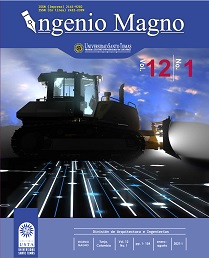Calculation of transient heat transfer for a standardized specimen for the Jominy test
Main Article Content
Abstract
Downloads
Article Details
DECLARATION OF ORGINIALITY OF SUBMITTED ARTICLE
With this document, I/We certify that the article submitted for possible publication in the institutional journal INGENIO MAGNO of the Research Center Alberto Magno CIIAM of the University Santo Tomás, Tunja campus, is entirely of my(our) own writing, and is a product of my(our) direct intellectual contribution to knowledge.
All data and references to completed publications are duly identified with their respective bibliographical entries and in the citations thus highlighted. If any adjustment or correction is needed, I(we) will contact the journal authorities in advance.
Due to that stated above, I(we) declare that the entirety of the submitted material is in accordance with applicable laws regarding intellectual and industrial property, and therefore, I(we) hold myself(ourselves) responsible for any complaint related to it.
If the submitted article is published, I(we) declare that I(we) fully relinquish publishing rights of the article to the University Santo Tomás, Tunja campus. As remuneration for this relinquishment of rights, I(we) declare my(our) agreement to receive two (2) copies of the edition of the journal in which my(our) article appears.
References
Abarca, L., Álvarez, M., Olivares, R., & Reyes, M. (2019). Laboratorio de tratamientos térmicos: Templabilidad. Santiago de Chile: Universidad de Santiago de Chile.
Spim, J. A., & Carlos Alexandre dos Santos. (2011). Representación en diferencias finitas de la transferencia de calor en la templabilidad del acero SAE 1045 finite difference. Investigación
Aplicada E Innovación, 5(1).
Martínez, F. (2019). Simulación numérica del tratamiento térmico de carburizado y temple de aceros de baja aleación. Posgrado Interinstitucional de Ciencia y Tecnología.
López E., Hernández J.B., Solorio G. Vergara H.J., Vázquez O. & Garnica P. (2013). Modelo matemático de la transferencia de calor para predecir el perfil de durezas en probetas Jominy. Revista de Metalurgia, 49 (2).
Pietrzyk M. &. Kuziak R (2011) Computer aided interpretation of results of the Jominy test. Archives of Civil and Mechanical Engineering. Vol XI. Nº 3. 707-722
Higuera, O., Tristancho, J., & Florez, L. (2007). Simulación térmica en CosmosWorks de un acero sometido a un ensayo de templabilidad Jominy. Scientia et Technica año XIII. (35).
Çengel, Y. A. (2007). Transferencia de calor y masa: un enfoque práctico. McGraw-Hill.
Incropera, F. P., & DeWitt, D. P. (1999). Fundamentos de transferencia de calor. Pearson Educación.
Perez Prieto, J. A. (2017). Curso de python científico (1st ed.)
Ansys. (2015). Mesh quality & advanced topics. In Ansys Inc (Ed.), Introduction to ANSYS meshing (pp. 12)

